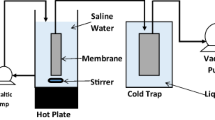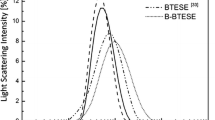Abstract
Silica membrane synthesis from tetraethoxysilane (TEOS) and methyltriethoxysilane (MTES) was carried out using ethanol-acetic acid solvent through a sol–gel process. The effects of TEOS-MTES mol composition of 100-0, 90-10, 75-25, 50-50, 25-75, 10-90, and 0-100 and calcination temperatures of 350 and 500 °C were studied. The water contact angle was used to examine the hydrophobicity of silica thin films. A close correlation between hydrophobicity and the presence of the Si−OH and C–H groups was obtained. Hydrophobicity was enhanced by increasing the C−H/Si−O−Si ratio and decreasing Si−OH/Si−O−Si ratio. Silica membrane material maintained hydrophobic properties up to 400 °C. Thermal stability went up with the rise in MTES content. All silica xerogels exhibited microporous character with decreased pore volume and surface area with lower TEOS content. The pervaporation technique systematically studied the TEOS-MTES silica membrane’s desalination performance using various saltwater concentrations and feed temperatures. The TEOS-MTES composition played an essential role in determining the membrane’s character and performance, salt rejection, and water fluxes. The high TEOS content led to high water flux. Alternatively, a high MTES content led to a high salt rejection. All membranes provided good salt rejection with values up to 99%, especially those with high MTES contents.

Graphical abstract
Highlights
-
Silica membranes are synthesized using tetraethylorthosilicate-methyltriethoxysilane.
-
There is a strong correlation between hydrophobicity with Si−OH and C−H groups.
-
The silica membrane material maintained hydrophobic properties up to 400 °C.
-
Precursor composition influences the performance of pervaporation desalination.
-
Silica membranes produce high-salt rejection and good water flux.












Similar content being viewed by others
References
Arenson LU, Colgan W, Marshall HP (2015) Chapter 2—physical, thermal, and mechanical properties of snow, ice, and permafrost. In: Shroder JF, Haeberli W, Whiteman C (eds) Snow and ice-related hazards, risks and disasters. Academic Press, Boston, https://doi.org/10.1016/B978-0-12-394849-6.00002-0
Cohen-Tanugi D, McGovern RK, Dave SH, Lienhard JH, Grossman JC (2014) Quantifying the potential of ultra-permeable membranes for water desalination. Energy Environ Sci 7(3):1134–1141. https://doi.org/10.1039/C3EE43221A
Wang Q, Li N, Bolto B, Hoang M, Xie Z (2016) Desalination by pervaporation: a review. Desalination 387:46–60. https://doi.org/10.1016/j.desal.2016.02.036
Charcosset C (2009) A review of membrane processes and renewable energies for desalination. Desalination 245(1):214–231. https://doi.org/10.1016/j.desal.2008.06.020
Drioli E, Stankiewicz AI, Macedonio F (2011) Membrane engineering in process intensification—an overview. J Membr Sci 380(1):1–8. https://doi.org/10.1016/j.memsci.2011.06.043
Beatriz M (2019) Growth patterns in mature desalination technologies and analogies with the energy field. Desalination 457:75–84. https://doi.org/10.1016/j.desal.2019.01.029
Xie Z, Ng D, Hoang M, Duong T, Gray S (2011) Separation of aqueous salt solution by pervaporation through hybrid organic–inorganic membrane: effect of operating conditions. Desalination 273(1):220–225. https://doi.org/10.1016/j.desal.2010.10.026
Liang B, Pan K, Li L, Giannelis EP, Cao B (2014) High performance hydrophilic pervaporation composite membranes for water desalination. Desalination 347:199–206. https://doi.org/10.1016/j.desal.2014.05.021
Elma M, Yacou C, Wang DK, Smart S, Diniz da Costa JC (2012) Microporous silica based membranes for desalination. Water 4:3. https://doi.org/10.3390/w4030629
Liang B, Zhan W, Qi G, Lin S, Nan Q, Liu Y, Cao B, Pan K (2015) High performance graphene oxide/polyacrylonitrile composite pervaporation membranes for desalination applications. J Mater Chem A 3(9):5140–5147. https://doi.org/10.1039/C4TA06573E
Elma M, Wang DK, Yacou C, da Costa JCD (2015) Interlayer-free P123 carbonised template silica membranes for desalination with reduced salt concentration polarisation. J Membr Sci 475:376–383. https://doi.org/10.1016/j.memsci.2014.10.026
Lia L, Dong J, Nenoff TM, Lee R (2004) Reverse osmosis of ionic aqueous solutions on aMFI zeolite membrane. Desalination 170(3):309–316. https://doi.org/10.1016/j.desal.2004.02.102
Aghaeinejad-Meybodi A, Ghasemzadeh K (2017) Chapter 8—silica membrane application for desalination process. In: Basile A, Ghasemzadeh K (eds) Current trends and future developments on (bio-) membranes. Elsevier: Amsterdam, Netherlands, https://doi.org/10.1016/B978-0-444-63866-3.00008-X
Elma M, Yacou C, da Costa CJD, Wang KD (2013) Performance and long term stability of mesoporous silica membranes for desalination. Membranes 3:3. https://doi.org/10.3390/membranes3030136
Yan H, Yuanhao W, Hongxing Y (2015) TEOS/silane-coupling agent composed double layers structure: a novel super-hydrophilic surface. Energy Procedia 75:349–354. https://doi.org/10.1016/j.egypro.2015.07.384
Rastegarpanah A, Mortaheb HR (2016) Surface treatment of polyethersulfone membranes for applying in desalination by direct contact membrane distillation. Desalination 377:99–107. https://doi.org/10.1016/j.desal.2015.09.008
Lin CXC, Ding LP, Smart S, da Costa JCD (2012) Cobalt oxide silica membranes for desalination. J Colloid Interface Sci 368(1):70–76. https://doi.org/10.1016/j.jcis.2011.10.041
Wijaya S, Duke MC, da Costa JCD (2009) Carbonised template silica membranes for desalination. Desalination 236(1):291–298. https://doi.org/10.1016/j.desal.2007.10.079
Darmawan A, Utari R, Saputra RE, Suhartana, Astuti Y (2018) Synthesis and characterization of hydrophobic silica thin layer derived from methyltrimethoxysilane (MTMS). IOP Conf Ser: Mater Sci Eng 299:012041. https://doi.org/10.1088/1757-899x/299/1/012041
Duke MC, Mee S, da Costa JCD (2007) Performance of porous inorganic membranes in non-osmotic desalination. Water Res 41(17):3998–4004. https://doi.org/10.1016/j.watres.2007.05.028
de Vos RM, Maier WF, Verweij H (1999) Hydrophobic silica membranes for gas separation. J Membr Sci 158(1):277–288. https://doi.org/10.1016/S0376-7388(99)00035-6
Castricum HL, Sah A, Kreiter R, Blank DHA, Vente JF, ten Elshof JE (2008) Hydrothermally stable molecular separation membranes from organically linked silica. J Mater Chem 18(18):2150–2158. https://doi.org/10.1039/B801972J
Elma M, Wang DK, Yacou C, Motuzas J, da Costa JCD (2015) High performance interlayer-free mesoporous cobalt oxide silica membranes for desalination applications. Desalination 365:308–315. https://doi.org/10.1016/j.desal.2015.02.034
Darmawan A, Motuzas J, Smart S, Julbe A, da Costa JCD (2016) Gas permeation redox effect of binary iron oxide/cobalt oxide silica membranes. Sep Purif Technol 171:248–255. https://doi.org/10.1016/j.seppur.2016.07.030
Darmawan A, Karlina L, Astuti Y, Sriatun JM, Wang DK, da Costa JCD (2016) Structural evolution of nickel oxide silica sol-gel for the preparation of interlayer-free membranes. J Non-Crystalline Solids 447:9–15. https://doi.org/10.1016/j.jnoncrysol.2016.05.031
Sheen Y-C, Chang W-H, Chen W-C, Chang Y-H, Huang Y-C, Chang F-C (2009) Non-fluorinated superamphiphobic surfaces through sol–gel processing of methyltriethoxysilane and tetraethoxysilane. Mater Chem Phys 114(1):63–68. https://doi.org/10.1016/j.matchemphys.2008.07.132
Mahadik SA, Mahadik SS (2021) Surface morphological and topographical analysis of multifunctional superhydrophobic sol-gel coatings. Ceram Int 47(20):29475–29482. https://doi.org/10.1016/j.ceramint.2021.07.115
Darmawan A, Handayani DL, Saputra RE (2021) Hydrophobic silica films derived from methyltriethoxysilane (MTES): Effect of pH and calcination temperature. Appl Phys A 127(9):649. https://doi.org/10.1007/s00339-021-04794-1
Li X, Zheng Y, Xu X, Xue C, Han Z, Yang H, Zhang X (2021) Fabrication of single-layer antireflective coating with environmental stability by modified SiO2 mixed sol. Colloids Surf A: Physicochemical Eng Asp 630:127553. https://doi.org/10.1016/j.colsurfa.2021.127553
Li Q, Qian F, Xue Z, Dong W, Han Y, Lu J (2021) Preparation and performance of modified SiO2 gel coating filter material. Fuhe Cailiao Xuebao/Acta Mater Compositae Sin 38(8):2489–2496. https://doi.org/10.13801/j.cnki.fhclxb.20201030.005
Ma Y, Lee HR, Okahana K, Kanezashi M, Yoshioka T, Tsuru T (2013) Preparation and characterization of methyl-modified hybrid silica membranes for gas separation. Desalination Water Treat 51(25-27):5149–5154. https://doi.org/10.1080/19443994.2013.768409
Castricum HL, Sah A, Geenevasen JAJ, Kreiter R, Blank DHA, Vente JF, ten Elshof JE (2008) Structure of hybrid organic–inorganic sols for the preparation of hydrothermally stable membranes. J Sol-Gel Sci Technol 48(1):11–17. https://doi.org/10.1007/s10971-008-1742-z
Saputra RE, Astuti Y, Darmawan A (2018) Hydrophobicity of silica thin films: the deconvolution and interpretation by Fourier-transform infrared spectroscopy. Spectrochimica Acta Part A: Mol Biomolecular Spectrosc 199:12–20. https://doi.org/10.1016/j.saa.2018.03.037
Yu Y, Wu X, Guo D, Fang J (2014) Preparation of flexible, hydrophobic, and oleophilic silica aerogels based on a methyltriethoxysilane precursor. J Mater Sci 49(22):7715–7722. https://doi.org/10.1007/s10853-014-8480-0
Wang J, Feng J, Zou X, Long Y, Tian X (2012) Effect of surface microstructure on the hydrophobicity of coatings. Prog Org Coat 74(4):777–780. https://doi.org/10.1016/j.porgcoat.2011.09.018
Homma H, Kuroyagi T, Izumi K, Mirley CL, Ronzello J, Boggs SA (1999) Diffusion of low molecular weight siloxane from bulk to surface. IEEE Trans Dielectr Electr Insulation 6(3):370–375. https://doi.org/10.1109/94.775625
Kavale MS, Mahadik DB, Parale VG, Wagh PB, Gupta SC, Rao AV, Barshilia HC (2011) Optically transparent, superhydrophobic methyltrimethoxysilane based silica coatings without silylating reagent. Appl Surf Sci 258(1):158–162. https://doi.org/10.1016/j.apsusc.2011.08.023
Brinker CJ, Scherer GW (2013) Sol-gel science: the physics and chemistry of sol-gel processing. Academic Press Inc, San Diego, California, US
Darmawan A, Rasyid SA, Astuti Y (2021) Modification of the glass surface with hydrophobic silica thin layers using tetraethylorthosilicate (TEOS) and trimethylchlorosilane (TMCS) precursors. Surf Interface Anal 53(3):305–313. https://doi.org/10.1002/sia.6917
Parvathy Rao A, Venkateswara Rao A, Pajonk GM (2007) Hydrophobic and physical properties of the ambient pressure dried silica aerogels with sodium silicate precursor using various surface modification agents. Appl Surf Sci 253(14):6032–6040. https://doi.org/10.1016/j.apsusc.2006.12.117
Rios X, Moriones P, Echeverría JC, Luquín A, Laguna M, Garrido JJ (2011) Characterisation of hybrid xerogels synthesised in acid media using methyltriethoxysilane (MTEOS) and tetraethoxysilane (TEOS) as precursors. Adsorption 17(3):583–593
Karlina L, Azmiyawati C, Darmawan A (2019) Synthesis and characterization of hydrophobic silica prepared by different acid catalysts. IOP Conf Ser: Mater Sci Eng 509(012065):1–8. https://doi.org/10.1088/1757-899X/509/1/012065
Darmawan A, Saputra RE, Astuti Y (2020) Structural, thermal and surface properties of sticky hydrophobic silica films: effect of hydrophilic and hydrophobic precursor compositions. Chem Phys Lett 761:138076. https://doi.org/10.1016/j.cplett.2020.138076
Cassie ABD, Baxter S (1944) Wettability of porous surfaces. Trans Faraday Soc 40:546–551. https://doi.org/10.1039/TF9444000546
Le D, Kongparakul S, Samart C, Phanthong P, Karnjanakom S, Abudula A, Guan G (2016) Preparing hydrophobic nanocellulose-silica film by a facile one-pot method. Carbohydr Polym 153:266–274. https://doi.org/10.1016/j.carbpol.2016.07.112
Darmawan A, Motuzas J, Smart S, Julbe A, da Costa JCD (2015) Binary iron cobalt oxide silica membrane for gas separation. J Membr Sci 474:32–38. https://doi.org/10.1016/j.memsci.2014.09.033
McCool BA, Hill N, DiCarlo J, DeSisto WJ (2003) Synthesis and characterization of mesoporous silica membranes via dip-coating and hydrothermal deposition techniques. J Membr Sci 218(1):55–67. https://doi.org/10.1016/S0376-7388(03)00136-4
Volentiru E, Nyári M, Szabó G, Hórvölgyi Z, Mureşan LM (2014) Silica sol–gel protective coatings against corrosion of zinc substrates. Periodica Polytechnica Chem Eng 58:61–66. https://doi.org/10.3311/PPch.7302
Prince JA, Rana D, Matsuura T, Ayyanar N, Shanmugasundaram TS, Singh G (2014) Nanofiber based triple layer hydro-philic/-phobic membrane—a solution for pore wetting in membrane distillation. Sci Rep 4(1):6949. https://doi.org/10.1038/srep06949
Samuel de Lint WB, Zivkovic T, Benes NE, Bouwmeester HJM, Blank DHA (2006) Electrolyte retention of supported bi-layered nanofiltration membranes. J Membr Sci 277(1):18–27. https://doi.org/10.1016/j.memsci.2005.10.004
Han X, Peng Y (2016) Light-scattering characteristics of hydrated ions in dilute solutions of major sea salts. Optik 127(3):1455–1459. https://doi.org/10.1016/j.ijleo.2015.11.013
Fidalgo A, Ciriminna R, Lopes L, Pandarus V, Béland F, Ilharco LM, Pagliaro M (2013) The sol-gel entrapment of noble metals in hybrid silicas: a molecular insight. Chem Cent J 7(1):161. https://doi.org/10.1186/1752-153X-7-161
Farmer VC, Russell JD (1964) The infra-red spectra of layer silicates. Spectrochimica Acta 20(7):1149–1173. https://doi.org/10.1016/0371-1951(64)80165-X
Aulia Rahma ME, Erdina Lulu Atika Rampun AEP, Arief Rakhman F (2020) Rapid thermal processing and long term stability of interlayer-free silica-P123 membranes for wetland saline water desalination. J Adv Res Fluid Mech Therm Sci 71(2):1–9. https://doi.org/10.37934/arfmts.71.2.19
Yang H, Wang DK, Motuzas J, da Costa JCD (2018) Hybrid vinyl silane and P123 template sol−gel derived carbon silica membrane for desalination. J Sol-Gel Sci Technol 85(2):280–289. https://doi.org/10.1007/s10971-017-4562-1
Ladewig BP, Tan YH, Lin CXC, Ladewig K, da Costa JCD, Smart S (2011) Preparation, characterization and performance of templated silica membranes in non-osmotic desalination. Materials 4(5):845. https://doi.org/10.3390/ma4040845
Xu J, Singh YB, Amy GL, Ghaffour N (2016) Effect of operating parameters and membrane characteristics on air gap membrane distillation performance for the treatment of highly saline water. J Membr Sci 512:73–82. https://doi.org/10.1016/j.memsci.2016.04.010
Kharraz JA, Bilad MR, Arafat HA (2015) Flux stabilization in membrane distillation desalination of seawater and brine using corrugated PVDF membranes. J Membr Sci 495:404–414. https://doi.org/10.1016/j.memsci.2015.08.039
Acknowledgements
AD and YA gratefully acknowledge the financial support provided by the Ministry of Research Technology and Higher Education of the Republic of Indonesia via the Penelitian Kompetensi (Hikom) (Number: 343-12/UN7.5.1/PP/2017). AD is incredibly grateful to FIM2lab at the University of Queensland, which had facilitated all FTIR, TGA, and GSA analyses.
Author information
Authors and Affiliations
Corresponding author
Ethics declarations
Conflict of interest
The authors declare no competing interests.
Additional information
Publisher’s note Springer Nature remains neutral with regard to jurisdictional claims in published maps and institutional affiliations.
Rights and permissions
About this article
Cite this article
Darmawan, A., Munzakka, L., Karlina, L. et al. Pervaporation membrane for desalination derived from tetraethylorthosilicate-methyltriethoxysilane. J Sol-Gel Sci Technol 101, 505–518 (2022). https://doi.org/10.1007/s10971-022-05754-8
Published:
Issue Date:
DOI: https://doi.org/10.1007/s10971-022-05754-8




